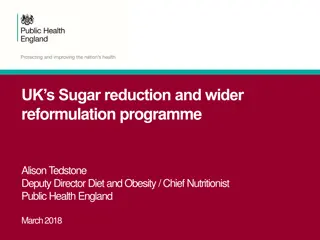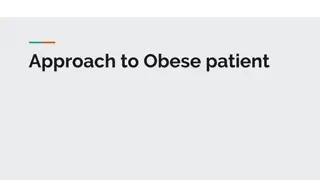Understanding Childhood Obesity: Causes, Effects, and Solutions
Childhood obesity is a significant health issue with various impacts on physical and emotional well-being. The World Health Organisation defines obesity as abnormal or excessive fat accumulation that poses health risks. Factors contributing to obesity include energy imbalance, poor dietary habits, and lack of physical activity. Obesity in children can lead to serious health conditions like high cholesterol, diabetes, and respiratory problems. Health professionals play a crucial role in identifying, preventing, and managing childhood obesity through interventions focused on education, nutrition, and lifestyle changes.
Uploaded on Sep 29, 2024 | 0 Views
Download Presentation

Please find below an Image/Link to download the presentation.
The content on the website is provided AS IS for your information and personal use only. It may not be sold, licensed, or shared on other websites without obtaining consent from the author. Download presentation by click this link. If you encounter any issues during the download, it is possible that the publisher has removed the file from their server.
E N D
Presentation Transcript
Childhood Obesity Caroline Rowley Paediatric Dietitian
Aim and objectives Aim: Identify the obese child, the influences that contribute to obesity and the interventions to help achieve and maintain a healthy weight Objectives: Understand the causes and effects of obesity Interpreting measurements Overview of the energy balance, nutritional requirements and influences Overview of government initiatives How health professionals can help and support
What is obesity and what are the statistics? World Health Organisation (WHO) has defined obesity as abnormal or excessive fat accumulation that presents a risk to health (WHO). It may be classed as overweight or obesity depending on measurements. Caused by an imbalance of energy in (food) and energy out (activity) The National Child Measurement Programme (NCMP) All children Overweight or obese Obese Reception 22.6% 9.7% 2018/19 Year 6 34.3% 20.2% 22.6% 33.4% 9.4% 2010/11 19% Reception Year 6 Areas of deprivation the worse affected
Why is it a problem? Emotional / behavioural / bullying / low self-esteem School absence High cholesterol / BP / pre-diabetes / bone & joint / breathing difficulties Increased risk of becoming overweight adults Risk of ill-health and premature mortality in adult life (Public Health England - Guidance on Childhood obesity: applying All Or Health May 2020) Obese children with asthma associated with a greater airflow obstruction and a mildly diminished response to inhaled corticosteroids (Jason E. Lang. Obesity, Nutrition and Asthma in Children. Paediatric Allergy Immunology and Pulmonology. 2012 Jun; 252): 64-75).
Interpreting measurements RCPCH growth charts BMI better indicator of overweight (can be used from age 2 years) Calculate BMI if weight alone is 75thC or weight and height C s differ Note: Weight alone >99.6thC almost always heavy BMI 91stC suggests overweight BMI 98thC obese Calculate BMI by dividing weight (in KG) by square of height (in Metres) Caution as BMI not specific for fat and changes as children grow Depending on level of obesity and age of child aim for them to grow into their weight
Energy balance Calories in: Boys and girls have different estimated calorie requirement for age e.g. (Kcal) Age (years) Boys 1-3 1230 1165 4-6 1715 1545 7-10 1970 11-14 2220 15-18 2755 2110 Girls 1740 1845 Calories out: Energy (kcal) used in physical activity (per hour) Video games 22-32 Bike riding 118-172 Skate boarding 74-108 Ballet 71-103
The Eatwell Guide A pictorial summary of the main food groups and their recommended portions for a healthy diet
Activity Regular physical activity: Helps develop movement skills Assists the Energy Balance and uses calories up to help maintain a healthy weight Cardiovascular benefits and strengthening bones NHS website: Physical activity guidelines for children (under 5 years) Physical activity guidelines for children and young people (aged 5-18) Sedentary activities: Useful: arts and crafts, reading Not useful: A child kept in a push chair when they could be walking, screen time etc.
Factors that influence obesity A complex interaction of biological, environmental and social factors influences the likelihood of a child gaining excess weight e.g. Diet Activity levels / exercise / hobbies sleep screen time Mental health Ethnic and cultural influences Socio-economic status Maternal obesity Family dynamics Genetic differences in appetite and metabolism Education (Home economics, GCSE food technology) (Food in the school curriculum in England: Its development from cookery to cookery Gwyneth Owen- Jackson, The Open University Marion Rutland, University of Roehampton)
How we used to eat! Mrs Beeton s everyday cookery (1963) Family food Variety At least one helping of protein at breakfast, midday, evening meal Children and expectant mothers - one pint of milk daily Enough fats, starches and sugars to satisfy appetite and allow normal growth in children / maintain body weight of adults One helping of potatoes and at least one serving of fresh vegetables, or salad or fruit to ensure an adequate amount of Vitamin C Snacks: redundant food is obtained by those who find themselves more than adequately nourished and should be watched carefully as the main meals by those who guard the family health
Life today! Processed high sugar, high fat food and drinks Lots of variety more variety means increased food consumption Lots of new food products e.g. plant-based foods, breakfast cereals Snacks Takeaway food and delivery meals (fast food) Ready meals Confectionary family sizes often more economical Crisps 90p per pack 1 for 6 packs Abundance of food Effects of advertising More food outlets / restaurants / caf s Working parents / carers Family time constraints More sedentary lifestyle
Calorie content of common foods Fruit Juice 1 litre carton 460 kcal Packet of crisps 184kcal Pizza (1 slice) average 250 kcal McDonald s medium fries 312 kcal Cola (355ml) 149 Kcal Milk chocolate buttons (119g) 636 Kcal
Nutrition labelling Provides information to make an informed choice when deciding what food and drink products to buy (Food Standards Agency)
Government strategies Soft drink industry levy Sugar tax 20% less by 2020 ingredients or product size. Funding to science and technology for development of healthier products School Food Standards / Early years settings Food labelling Change4Life Sugar Smart app Health professional resources to support confidence discussing nutrition and weight issues All Our Health: Childhood Obesity https://portal.e- lfh.org.uk/Component/Details/587409 National Child Measurement Programme (NCMP) Children and young people at least 60 mins mod-vigorous activity per day Investment in sports and physical activity programmes in schools, outside of school and walking and cycling to school (Bikeability cycle training for children) September 2017 introduction of voluntary health rating scheme for schools (Ofsted) HENRY
What research tells us.. Family based lifestyle interventions are the most effective: Niemeier B.S et al. Parent participation in weight-related health interventions for children and adolescents: A systematic review and meta-analysis. Preventative Medicine; volume 55, Issue 1, July 2012 Interventions consisted of nutrition education, physical activity education / sessions, behaviour education / therapy The study suggested that parent participation more effectively reduced BMI in child and adolescent participants and the longer they are involved the more effective.
Actions to help Raise the issue! Provide consistent evidence based advice Health professional resources to support confidence discussing nutrition and weight issues All Our Health: Childhood Obesity https://portal.e-lfh.org.uk/Component/Details/587409 Look at local Trust obesity guidelines signposts where to refer / co-moribidities and complex features Paediatric dietitian Specialist childhood obesity services e.g. HENRY Initial advice: First step regular meals What are the barriers (family, parenting issues, child always hungry etc..) Check diet include food and drinks (e.g. portion sizes, snacks, meal frequency, drinks) Lifestyle hobbies, activities, screen time, sleep etc. Psychological support Signpost to locally available activities see local council website Encourage walking, using stairs instead of lifts, avoiding over use of push chairs etc.
Nutrition and Dietetics Whittington Health Magdala Avenue London N19 5NF Tel: 020 7288 5851























